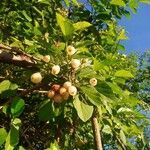Shrubs, or trees to 25 m, coarsely pubescent. Leaves alternate, ovate to obovate, sparsely mucronate-dentate, blunt-acute (slightly mucronate), the bases obtuse to rounded, to 12 cm long and 7 cm wide, coarsely pubescent, the hairs with multicellular bases; petioles to 2 cm long. Inflorescences irregular panicles, the apices scorpioid, ca 10-13 cm long and wide, terminal. Flowers perfect, + sessile; calyx tubular, ca 10-ribbed, 3-4 mm long, 3(-5)-lobed, sparsely strigose on the ribs; corolla white to cream, funnelform, the tube ca 3-4 mm long with 5 widely spreading lobes 6-8 mm long, glabrous; stamens 5, borne on the corolla throat, the free filament 3-4 mm long, sparsely strigose at the point of attach-ment, the anthers ca 1.7-1.9 mm long; ovary bottle-shaped, the style ca 2-3 mm long, divided and the branches redivided near the apices, the stigmas 4. Fruit ovoid, with fleshy exocarp and bony endocarp, white, to 1.5 cm long.
More
A small tree. It grows 10 m tall. The leaves are slightly fuzzy. The tree loses its leaves during long droughts. It remains evergreen with sufficient water. The flowers occur in clusters. They are crinkly, papery and yellow. They have a sweet scent. The fruit are fleshy and white. The fruit have a sweet sticky pulp.
Dry, sandy or rocky slopes and hills, damp or dry thickets or mixed forest; grassy plains and pastures, from sea level to elevations of 900 metres.
More
A tropical plant. It is native to tropical America.


